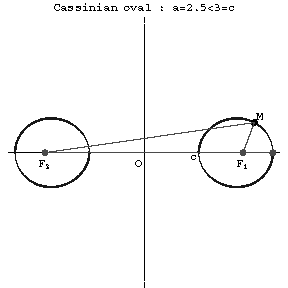Cassini oval
From Encyclopedia of Mathematics
A plane algebraic curve of order four whose equation in Cartesian coordinates has the form:
 |

Figure: c020700a

Figure: c020700b

Figure: c020700c
A Cassini oval is the set of points (see Fig.) such that the product of the distances from each point to two given points  and
and  (the foci) is constant. When
(the foci) is constant. When  the Cassini oval is a convex curve; when
the Cassini oval is a convex curve; when  it is a curve with "waists" (concave parts); when
it is a curve with "waists" (concave parts); when  it is a Bernoulli lemniscate; and when
it is a Bernoulli lemniscate; and when  it consists of two components. Cassini ovals are related to lemniscates. Cassini ovals were studied by G. Cassini (17th century) in his attempts to determine the Earth's orbit.
it consists of two components. Cassini ovals are related to lemniscates. Cassini ovals were studied by G. Cassini (17th century) in his attempts to determine the Earth's orbit.
References
| [1] | A.A. Savelov, "Planar curves" , Moscow (1960) (In Russian) |
Comments
A Cassini oval is also called a Cassinian oval.
References
| [a1] | J.D. Lawrence, "A catalog of special plane curves" , Dover, reprint (1972) MR1572089 Zbl 0257.50002 |
| [a2] | J.W. Bruce, P.J. Giblin, "Curves and singularities: a geometrical introduction to singularity theory" , Cambridge Univ. Press (1984) MR1541053 Zbl 0534.58008 |
How to Cite This Entry:
Cassini oval. Encyclopedia of Mathematics. URL: http://encyclopediaofmath.org/index.php?title=Cassini_oval&oldid=31950
Cassini oval. Encyclopedia of Mathematics. URL: http://encyclopediaofmath.org/index.php?title=Cassini_oval&oldid=31950
This article was adapted from an original article by D.D. Sokolov (originator), which appeared in Encyclopedia of Mathematics - ISBN 1402006098. See original article